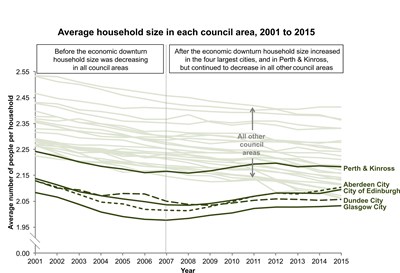Household numbers continue to rise
The number of households in Scotland has continued to increase, though the rate of growth is smaller than before the economic downturn.
There were 2.43 million households in 2015, according to figures published today by National Records of Scotland (NRS) in 'Estimates of Households and Dwellings in Scotland, 2015'.
The number of households in Scotland has grown by around 160,000 over the last ten years. Household numbers have been growing faster than the population. Since 2005, Scotland’s population has risen by five per cent, whilst the number of households has increased by seven per cent. This is because more people are living alone and in smaller households. This is reflected in the average number of people per household, which has fallen from 2.21 people per household in 2005 to 2.17 in 2015.
Tim Ellis, the Chief Executive of National Records of Scotland, said:
“These latest figures from the National Records of Scotland show household numbers continue to rise but the level of growth has changed, with the number of households rising by a much smaller amount each year after the beginning of the economic downturn. In most council areas, average household size continues to fall, but average household sizes are now rising in the four city council areas of Aberdeen City, Dundee City, City of Edinburgh and Glasgow City, and in Perth and Kinross. This may be linked to the trend we are seeing of more young adults living with their parents or renting rather than buying a home.”
These changes in average household size are illustrated in the chart below.
Every council area in Scotland has experienced a rise in household numbers over the past ten years, although the size of the increase varies widely. The largest percentage increases were in the Orkney Islands and Highland (13.6 per cent and 12.7 per cent respectively). City of Edinburgh saw the largest rise in absolute numbers (18,283, 8.6 per cent).
The overall number of dwellings (including vacant properties and second homes) also rose in 2015, to a total of 2.56 million. This was 161,000 more than in 2005. In Scotland as a whole, 3.1 per cent dwellings were vacant and 1.1 per were second homes, with the latter being more common in more rural areas.
Notes To Editors
1. These figures are based on a National Statistics publication released today by National Records of Scotland (NRS):
‘Estimates of Households and Dwellings in Scotland, 2015’
2. These statistics are mainly used for informing decisions about housing need and service provision.
1. A ‘dwelling’ refers to the accommodation itself, for example, a house or a flat. A ‘household’ refers to the people living together in that dwelling. The number of households will be smaller than the number of dwellings, as some dwellings are vacant or second homes.
1. In 2013, the Scottish Government introduced legislation which allows councils to increase the Council Tax charges on certain long-term empty properties. It also made slight changes to the definitions of such properties and second homes. The aim of the legislation is to encourage empty home owners to bring their properties back into use. More information on this, and other empty homes initiatives, can be found on the Scottish Government website at: http://www.gov.scot/Topics/Built-Environment/Housing/supply-demand/emptyhomes
1. Further statistics produced by NRS, and information about our statistics, can be accessed at: http://www.nrscotland.gov.uk/statistics-and-data
There is a problem
Thanks for your feedback
